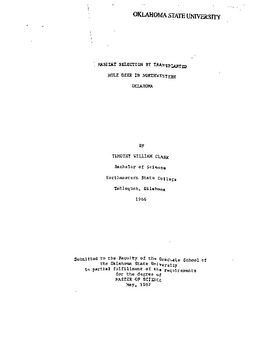| dc.contributor.advisor | Stebler, A. M. | |
| dc.contributor.author | Clark, Timothy William | |
| dc.date.accessioned | 2016-01-27T22:26:42Z | |
| dc.date.available | 2016-01-27T22:26:42Z | |
| dc.date.issued | 1967-05 | |
| dc.identifier.uri | https://hdl.handle.net/11244/26917 | |
| dc.description.abstract | Scope and Method of Study: During 1965, sixty-five mule deer, captured in northwest Colorado, were transplanted to four localities in northwestern Oklahoma. Transplants were 200 miles east of the presently know mule deer range in Oklahoma. Attempts, beginning five months after the releases, to locate the mule deer within the areas of release were unsuccessful. Assuming that the transplanted mule deer had moved out of the release areas, a new approach was indicated. Ecological factors associated with mule deer habitat were measured on a type area. Data were analyzed in an attempt to find one or more common denominators characteristic of mule deer habitat. These data were compared with that from the transplant areas. | |
| dc.description.abstract | Findings and Conclusions: Mule deer were observed in every zone (mesa tops, slopes, and canyon floors) on the type area. Despite their general occupation of the whole region mule deer showed marked preferences for particular ecological situations. On the type area 91.3% of the mule deer seen in resting cover and 98.0% of those in flight were in association with the slope zone. The slope zone contained trees and shrubs. This combination of life-form elements (trees-shrubs) was absent from the mesa tops and canyon floors of the type area and also absent from ell the release sites. The type area can be characterized as a mesa-canyon topographic type with biotic affinities with the foothills of the southern Rocky Mountains. The general release region is characterized as a rolling to strongly sloping upland prairie dissected by large gully-like drainage ways. Only five sightings of the transplanted mule deer have come to my attention. As reported these deer were seen within approximately one mile of the nearest release site and within about one month of the release date. Four deaths (6.1%) occurred shortly after release and two deer were found to be heavily parasitized by ticks. One doe was treated for pneumonia and re-released. No evidence was found to suggest that Rocky Mountain mule deer were ever associated with the type of vegetation characteristic of the release sites. | |
| dc.format | application/pdf | |
| dc.language | en_US | |
| dc.rights | Copyright is held by the author who has granted the Oklahoma State University Library the non-exclusive right to share this material in its institutional repository. Contact Digital Library Services at lib-dls@okstate.edu or 405-744-9161 for the permission policy on the use, reproduction or distribution of this material. | |
| dc.title | Habitat selection by transplanted mule deer in northwestern Oklahoma | |
| dc.contributor.committeeMember | Crockett, J. J. | |
| dc.contributor.committeeMember | Glass, B. P. | |
| osu.filename | Thesis-1967R-C595h.pdf | |
| osu.accesstype | Open Access | |
| dc.type.genre | Master's Report | |
| dc.type.material | Text | |
| thesis.degree.discipline | Zoology | |
| thesis.degree.grantor | Oklahoma State University | |
